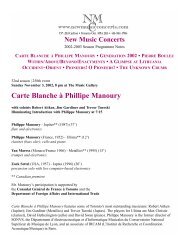2004-2005 Season The Hammerhead Consort - New Music Concerts
2004-2005 Season The Hammerhead Consort - New Music Concerts
2004-2005 Season The Hammerhead Consort - New Music Concerts
You also want an ePaper? Increase the reach of your titles
YUMPU automatically turns print PDFs into web optimized ePapers that Google loves.
KEITH HAMEL (Canada 1956) Krishna’s Flute<br />
for flute and interactive electronics (<strong>2004</strong>)<br />
Breathe on me breath of God<br />
Fill me with life anew<br />
That I may love what thou wouldst love<br />
And do what thou wouldst do.<br />
E. Hatch (1835–1889)<br />
— Robert Pritchard<br />
Keith Hamel was born in 1956 in Morden, Manitoba. He is known both as a composer and a music software<br />
developer. He studied music at the Royal Conservatory of <strong>Music</strong> of Toronto and Queen’s University in<br />
Canada, and pursued graduate studies at Harvard University and the Massachusetts Institute of Technology in<br />
the USA. He holds a Ph.D. in <strong>Music</strong> from Harvard University. Hamel has written both acoustic and<br />
electroacoustic music and has been awarded many prizes in both media. His works have been performed by<br />
many of the finest soloists and ensembles both in Canada and abroad. He has received commissions from<br />
IRCAM (Paris), the Ensemble Intercontemporain, Vancouver Symphony Orchestra, Vancouver <strong>New</strong> <strong>Music</strong><br />
Ensemble, the Elektra Women’s Choir, musica intima, <strong>Hammerhead</strong> <strong>Consort</strong>, Standing Wave, as well as from<br />
outstanding performers such as flutist Robert Cram, bassoonist Jesse Read, clarinetist Jean-Guy Boisvert,<br />
saxophonist Julia Nolan, and pianist Douglas Finch. Many of his recent compositions focus on interaction<br />
between live performers and computer-controlled electronics.<br />
As a software developer, Hamel is recognized as one of the foremost authorities on music notation software.<br />
Keith Hamel is the President of the Canadian <strong>Music</strong> Centre, the Vice-President of the International Society of<br />
Contemporary <strong>Music</strong>, and a Councillor of the Canadian League Of Composers. He has been a professor of<br />
composition and Director of the Computer <strong>Music</strong> Studio at the University of British Columbia in Vancouver<br />
since 1987 and his music is published by Éditions <strong>Music</strong>ales Européennes of Paris and Cypress Publishing in<br />
Vancouver.<br />
Krishna’s Flute is the fourth in a series of compositions that I have written for solo performer and interactive<br />
computer processing. A computer monitors the live flute performance, and using a variety of sound processors,<br />
samplers and software synthesizers designed by the composer, it extends the instrument and its sound world in<br />
strange (and I hope) wonderful ways. <strong>The</strong> result is a kind of hyper-flute; a flute that produces sounds that are<br />
far beyond the instrument’s normal limitations. While some fairly complex technologies are used in the<br />
composition, the performer is free to play expressively and sensitively; the technology remains in the<br />
background and follows the nuances of the live performance. <strong>The</strong> Hindu god Krishna played the flute, and he<br />
played so beautifully and magically that everyone who heard his music immediately fell in love with him. This<br />
image forms the inspiration for my composition. <strong>The</strong> work is intended to be sensual, emotional, and evocative.<br />
<strong>The</strong> text fragments used in the composition are taken from translations of ancient Sanskrit love<br />
poems.Krishna’s Flute was composed between 2000 and <strong>2004</strong>. It was commissioned by Robert Cram with the<br />
assistance of the Canada Council for the Arts. <strong>The</strong> computer software designed and developed for this<br />
composition was supported by funding from the Social Sciences and Humanities Research Council.<br />
— Keith Hamel




